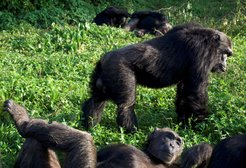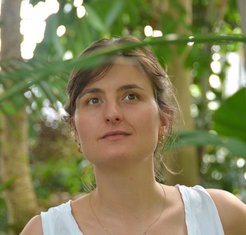Living side by side with chimpanzees
Lou Marie Haux from the Max Planck Institute for Human Development in Berlin spent three months on Ngamba Island in Uganda studying the risk behavior of chimpanzees. In this article, she reports on her behavioral studies, on everyday life on a small island and her most cherished moments.

Ngamba Island is situated in the middle of Lake Victoria, and covers an area of around 40 hectares. It is accessible only by boat. The island has been home to a sanctuary for orphaned chimpanzees since 1998. Some of the animals were saved from the bushmeat trade and brought to the forested island. To reach the chimpanzees, I fly to Entebbe from Berlin. From there, a two-hour boat trip across Lake Victoria takes me to Ngamba Island.
Most of the island is inhabited by the chimpanzees - one of our closest relatives. Apart from myself and my research colleague from Warwick University in England, there are a keeper and cooks on the island. Our accommodation is limited to eight small houses that are located directly next to the places where the chimpanzees sleep.

For the 49 chimpanzees, secure sleeping places and regular feeding times are necessary for survival, since the forest, which grows on most of the island, offers only enough food for a small number of chimpanzees. If they were to sleep in the forest, then it would be completely devastated within a very short space of time, since chimpanzees usually build a new nest to sleep in every night.
The chimpanzees dictate our daily rhythm. They are fed early in the morning, and are then most amenable for our behavioral studies. It is fascinating to watch how the animals think, reflect and make decisions. For example, in one study, the chimpanzees can either secure a peanut for themselves or take a risk; in so doing,
they can either double their win, or go empty-handed. I am mainly interested in whether the risk preferences of chimpanzees and humans differ, or where any common features can be observed. The goal of my research is to find out more about the evolutionary origins of human risk behavior.
As soon as the studies have been completed, the chimpanzees fan out into the rainforest. There, they disappear into the trees and are not bothered by us humans. During that time, I focus on other aspects of my research work: data input, video coding, or initial study analyses. Even though there are few people here, and the activities are repetitive, everyday life on the island is anything but boring. Countless plants, birds, bats and monitor lizards make every day unique – and anyway, with the chimpanzees, no one day is like another. Sometimes we travel to Entebbe to buy necessities, although we spend most of our time on Ngamba. Whenever I leave the boat, I’m really excited to be back on the island.
When darkness falls, the chimpanzees return “home”, are fed and get ready for the night. I also go to bed relatively early, just a few meters away from their sleeping places. Often, after a long and arduous day researching, I lie exhausted on the bed and can clearly hear how these animals that I have come to love so much build their nests, make themselves comfortable in their hammocks and communicate with each other. Then I feel connected to them in a very special way. For me, these are the moments on Ngamba Island that I cherish the most.













